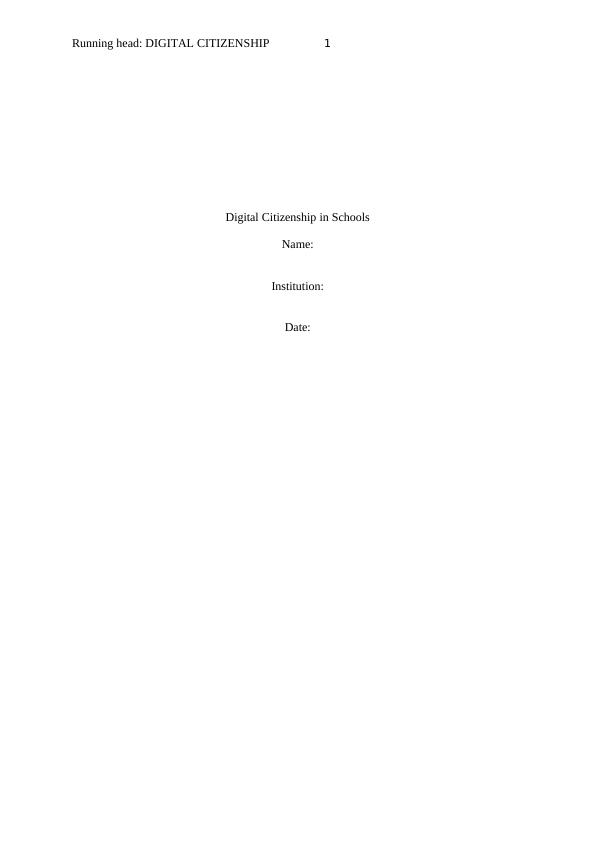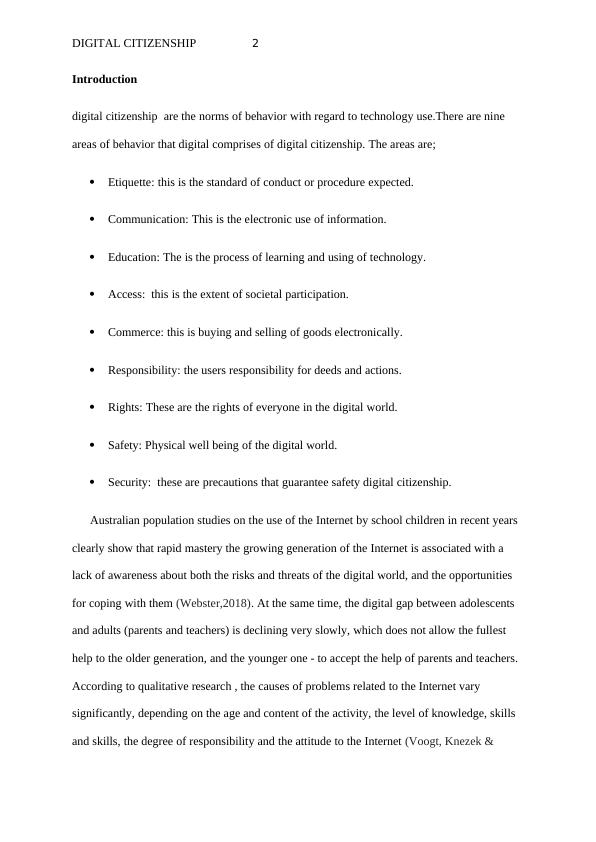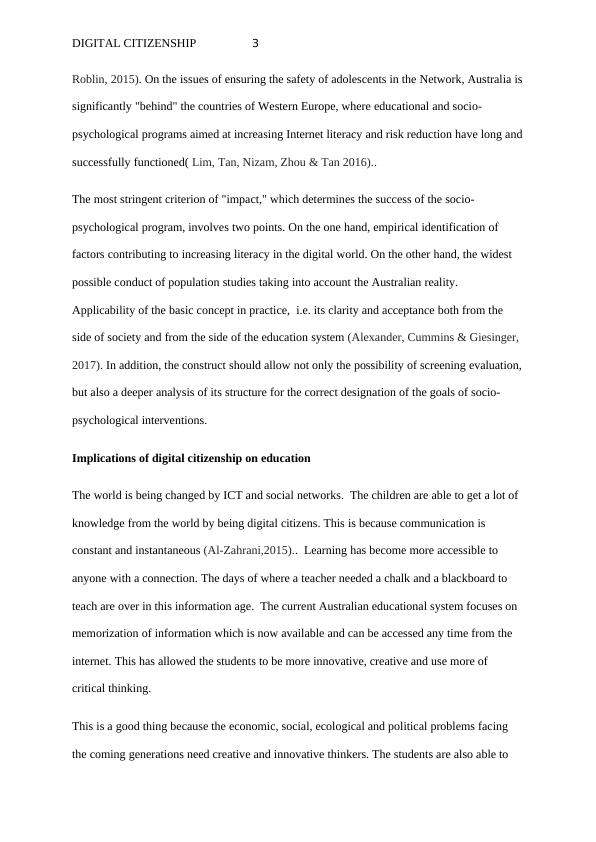Digital Citizenship in Schools - PDF
Added on 2021-05-31
13 Pages3768 Words17 Views
Running head: DIGITAL CITIZENSHIP 1
Digital Citizenship in Schools
Name:
Institution:
Date:
Digital Citizenship in Schools
Name:
Institution:
Date:

DIGITAL CITIZENSHIP 2
Introduction
digital citizenship are the norms of behavior with regard to technology use.There are nine
areas of behavior that digital comprises of digital citizenship. The areas are;
Etiquette: this is the standard of conduct or procedure expected.
Communication: This is the electronic use of information.
Education: The is the process of learning and using of technology.
Access: this is the extent of societal participation.
Commerce: this is buying and selling of goods electronically.
Responsibility: the users responsibility for deeds and actions.
Rights: These are the rights of everyone in the digital world.
Safety: Physical well being of the digital world.
Security: these are precautions that guarantee safety digital citizenship.
Australian population studies on the use of the Internet by school children in recent years
clearly show that rapid mastery the growing generation of the Internet is associated with a
lack of awareness about both the risks and threats of the digital world, and the opportunities
for coping with them (Webster,2018). At the same time, the digital gap between adolescents
and adults (parents and teachers) is declining very slowly, which does not allow the fullest
help to the older generation, and the younger one - to accept the help of parents and teachers.
According to qualitative research , the causes of problems related to the Internet vary
significantly, depending on the age and content of the activity, the level of knowledge, skills
and skills, the degree of responsibility and the attitude to the Internet (Voogt, Knezek &
Introduction
digital citizenship are the norms of behavior with regard to technology use.There are nine
areas of behavior that digital comprises of digital citizenship. The areas are;
Etiquette: this is the standard of conduct or procedure expected.
Communication: This is the electronic use of information.
Education: The is the process of learning and using of technology.
Access: this is the extent of societal participation.
Commerce: this is buying and selling of goods electronically.
Responsibility: the users responsibility for deeds and actions.
Rights: These are the rights of everyone in the digital world.
Safety: Physical well being of the digital world.
Security: these are precautions that guarantee safety digital citizenship.
Australian population studies on the use of the Internet by school children in recent years
clearly show that rapid mastery the growing generation of the Internet is associated with a
lack of awareness about both the risks and threats of the digital world, and the opportunities
for coping with them (Webster,2018). At the same time, the digital gap between adolescents
and adults (parents and teachers) is declining very slowly, which does not allow the fullest
help to the older generation, and the younger one - to accept the help of parents and teachers.
According to qualitative research , the causes of problems related to the Internet vary
significantly, depending on the age and content of the activity, the level of knowledge, skills
and skills, the degree of responsibility and the attitude to the Internet (Voogt, Knezek &

DIGITAL CITIZENSHIP 3
Roblin, 2015). On the issues of ensuring the safety of adolescents in the Network, Australia is
significantly "behind" the countries of Western Europe, where educational and socio-
psychological programs aimed at increasing Internet literacy and risk reduction have long and
successfully functioned( Lim, Tan, Nizam, Zhou & Tan 2016)..
The most stringent criterion of "impact," which determines the success of the socio-
psychological program, involves two points. On the one hand, empirical identification of
factors contributing to increasing literacy in the digital world. On the other hand, the widest
possible conduct of population studies taking into account the Australian reality.
Applicability of the basic concept in practice, i.e. its clarity and acceptance both from the
side of society and from the side of the education system (Alexander, Cummins & Giesinger,
2017). In addition, the construct should allow not only the possibility of screening evaluation,
but also a deeper analysis of its structure for the correct designation of the goals of socio-
psychological interventions.
Implications of digital citizenship on education
The world is being changed by ICT and social networks. The children are able to get a lot of
knowledge from the world by being digital citizens. This is because communication is
constant and instantaneous (Al-Zahrani,2015).. Learning has become more accessible to
anyone with a connection. The days of where a teacher needed a chalk and a blackboard to
teach are over in this information age. The current Australian educational system focuses on
memorization of information which is now available and can be accessed any time from the
internet. This has allowed the students to be more innovative, creative and use more of
critical thinking.
This is a good thing because the economic, social, ecological and political problems facing
the coming generations need creative and innovative thinkers. The students are also able to
Roblin, 2015). On the issues of ensuring the safety of adolescents in the Network, Australia is
significantly "behind" the countries of Western Europe, where educational and socio-
psychological programs aimed at increasing Internet literacy and risk reduction have long and
successfully functioned( Lim, Tan, Nizam, Zhou & Tan 2016)..
The most stringent criterion of "impact," which determines the success of the socio-
psychological program, involves two points. On the one hand, empirical identification of
factors contributing to increasing literacy in the digital world. On the other hand, the widest
possible conduct of population studies taking into account the Australian reality.
Applicability of the basic concept in practice, i.e. its clarity and acceptance both from the
side of society and from the side of the education system (Alexander, Cummins & Giesinger,
2017). In addition, the construct should allow not only the possibility of screening evaluation,
but also a deeper analysis of its structure for the correct designation of the goals of socio-
psychological interventions.
Implications of digital citizenship on education
The world is being changed by ICT and social networks. The children are able to get a lot of
knowledge from the world by being digital citizens. This is because communication is
constant and instantaneous (Al-Zahrani,2015).. Learning has become more accessible to
anyone with a connection. The days of where a teacher needed a chalk and a blackboard to
teach are over in this information age. The current Australian educational system focuses on
memorization of information which is now available and can be accessed any time from the
internet. This has allowed the students to be more innovative, creative and use more of
critical thinking.
This is a good thing because the economic, social, ecological and political problems facing
the coming generations need creative and innovative thinkers. The students are also able to

DIGITAL CITIZENSHIP 4
question everything. Thus, facilitating a curriculum that focuses on digital aspect is great.
We have seen companies such as Google in the recent past launching a Digital literacy and
citizenship curriculum (Jones & Mitchell, 2016).. Most schools in Australia have supported
the BYOD (Bring Your Own Device) initiative which seeks to show how the digital
citizenship has been welcomed. The digital citizenship program is collaborative which
ensures that studenst, teachers and parents contribute in the learning and development of an
individual. This has encouraged communication between the various stakeholders in the
education sector. The use of papers has also reduced in schools because most learning
institutions use apps in teaching. There has been a reduction of bullying cases or other
internet related issues after the rollout of digital citizenship program.
Appropriate technology behavior for students aged 5-18 Years
It has been observed that that there has been an increase in sedentary behaviors among
students aged 5-18 Years. Digital citizenship has contributed to this trend as most students
spend their after school time either on their computers or watching TVs. Emerging evidence
shows that this students are at risk of developing health complications. There has been an
increase in adiposity, poor self esteem, poor academic achievement and decreased fitness
among the students in this age bracket.
Thanks to advances in technology, Australian schools have also benefited from new systems,
devices, programs, services and others, which promise to be the solution to learning
problems, offering products that will allow an experiential, perhaps immersive, learning the
students (Searson, Hancock, Soheil, & Shepherd, 2015).. This fact, added to the discourse of
the "digital natives" has been a "business boom" for many companies and experts in
innovation, as well as for schools that have entered into serious competition to acquire more
question everything. Thus, facilitating a curriculum that focuses on digital aspect is great.
We have seen companies such as Google in the recent past launching a Digital literacy and
citizenship curriculum (Jones & Mitchell, 2016).. Most schools in Australia have supported
the BYOD (Bring Your Own Device) initiative which seeks to show how the digital
citizenship has been welcomed. The digital citizenship program is collaborative which
ensures that studenst, teachers and parents contribute in the learning and development of an
individual. This has encouraged communication between the various stakeholders in the
education sector. The use of papers has also reduced in schools because most learning
institutions use apps in teaching. There has been a reduction of bullying cases or other
internet related issues after the rollout of digital citizenship program.
Appropriate technology behavior for students aged 5-18 Years
It has been observed that that there has been an increase in sedentary behaviors among
students aged 5-18 Years. Digital citizenship has contributed to this trend as most students
spend their after school time either on their computers or watching TVs. Emerging evidence
shows that this students are at risk of developing health complications. There has been an
increase in adiposity, poor self esteem, poor academic achievement and decreased fitness
among the students in this age bracket.
Thanks to advances in technology, Australian schools have also benefited from new systems,
devices, programs, services and others, which promise to be the solution to learning
problems, offering products that will allow an experiential, perhaps immersive, learning the
students (Searson, Hancock, Soheil, & Shepherd, 2015).. This fact, added to the discourse of
the "digital natives" has been a "business boom" for many companies and experts in
innovation, as well as for schools that have entered into serious competition to acquire more

End of preview
Want to access all the pages? Upload your documents or become a member.
Related Documents
Child Education Report 2022lg...
|11
|3378
|39
Cyberbullying Affects Children : Research Reportlg...
|12
|3187
|112
THE HEALTH PROM0TIONlg...
|12
|898
|39
